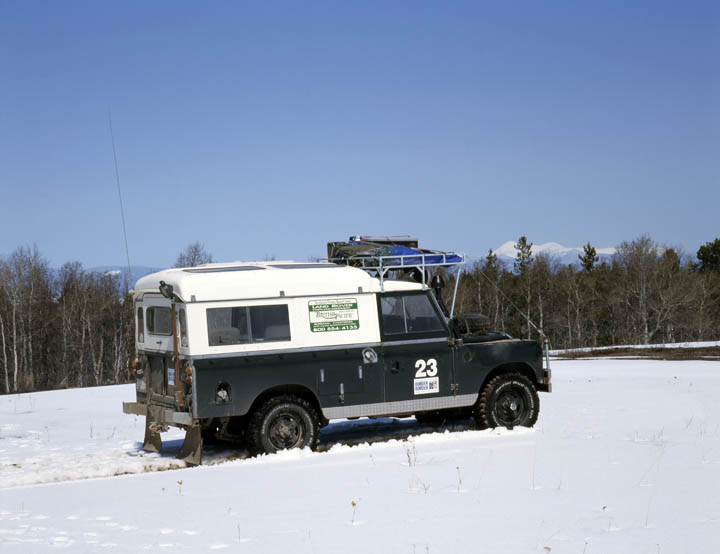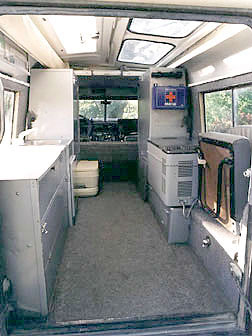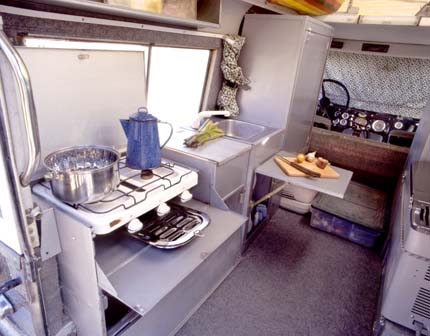Vehicle: 1960 Land Rover Dormobile
Basic stats for my Land Rover:
Ford 302 engine, Borg Warner T-18 gearbox, Land Rover transfercase with high ratio high range gears installed. Front axle has hardened 24 spline axles, TruTrac diff and uprated R&P. Disc brakes on the front. Rear axle is a Salisbury (Dana 60 made under license by Land Rover). Inside are hardened 24 spline axles & an ARB air locker. Rear brakes are stock drums. R&P ratio is 4.75:1, low range first is 70:1, 65 MPH is 2650 RPM.
She has 3 fuel tank with a capacity of 42 gallons, a built in 5 gallon propane tank, 15 gallon water tank and 2.5 gallon air tank (with Quickair2 compressor).
This is the rear interior fully loaded for a long trip and the pop up top lowered.
Left side rear to front: Cooker unit with two burners, broiler and sink. Second sink cabinet with top hinged door to also serves as a work table. Storage cabinet with porta pottie stowed at base. Above there are a small cabinet and a fold out bed.
Right side rear to front: Back corner is a Quickair 2 compressor, fold down jump seat, (second battery below jump seat) Norcold chest refrigerator sitting on a cabinet (storage for 7 qts oil, power steering fluid, oil & fuel filters below refrigerator), storage cabinet with flip up seat. A second top bunk can be installed along this side. Above the back door is a tea cabinet.
I can go from driving on the trail to camp completely set up in under 2 minutes in any weather. I can go from driving to camp set up, fresh salad made, glass of wine poured and dinner cooking in under 5 minutes.
Series & Defender Land Rovers in general:
The Good:
The big plus is that they are the ultimate off road vehicle erector set. The body panels are bolted and riveted together. The interior is a rectangular box, there are several under body places at frame level to mount things in protected external space where it takes up no external or internal space. Between 1958 and 2008 most body panels are bolt on interchangeable and there are many body panels from the different models to choose from (I've seen one that was modified to have 4 door panels on one side and 2 door panels on the other. Wheel base ranges from 88 inches through 127 inches. They have a big box latter style box frame and an aluminum body which helps keep the centre of gravity low.
The roof unbolts allowing you to drive topless, with a canvas top, pick up top or a number of different hard top configurations or even unbolt the rear body and add an ambulance rear body. There's even a 6X6 version, multiple tracked versions and amphibious versions as well.
Series were introduced in 1948. The Series I was in production through 1957. They are very light weight, rugged but the engines are small and hard to get parts for. The Series I 80 inch wheelbase would be a good platform for a light weight day trip rig where rugged simplicity is king. I think these would be perfect for a RV towed trail rig. Put a Land Rover 200tdi in it and you would have plenty of torque and 30 or more MPG on the trail.
The Series II 2 was introduced in 1958 and the same basic body style is still in production. The transfer case is very strong and running dry is about the only thing that kills them.
Series Land Rovers are easy to work on. One might say that they were designed to be worked on in the jungle with little more than a screw driver and an adjustable spanner. Defenders are more complicated but not by that much. These lend themselves well to field repairs.
The Bad:
Series Land Rovers are woefully underpowered. The 2.25L petrol engine was optimistically rated at 70 HP. Diesels at 60 HP. The tdi engines were never sold in the States, but the 200 tdi (about 115 HP) bolts to a Series gearbox.
The Rover aluminum V8 is fragile, easily destroyed by overheating, needs premium and gets worse fuel mileage then the carb'ed Series 4 cyl engine. The LT77 gearbox is also quite weak.
The Series gearbox is a was designed in the 1930's and 160 lbft is about the limit on torque the box can handle.
The Land Rover 10 spline axle is very weak and rear axles should be considered to be consumables (The good news is that the Land Rover has full floating axles so the wheels won't fall off). Upgrades to the much stronger 24 spline axle is bolt in, an even bigger 30 spline axle upgrade requires a little bit of machining and some folks are putting Toyota axles & lockers under Land Rovers.
There is not a whole lot of leg space and it gets really tight for someone over 6 foot tall (Defenders are a bit better in that respect).
Series Land Rovers have poor front articulation and medium rear articulation. At both ends articulation is limited by the extension of the shocks (Defenders have the shock mounts farther apart). Also, the front leaf springs are very short and the shackle location is wrong for good front articulation. Some people address this by installing longer leaf springs at the front. Defenders, with their coil springs have more articulation than their older Series siblings. But a Series can be made to articulate as well as a coiler with a bit of effort.
There are other weak points, but these are the biggies.
A Series Land Rover is a very primitive vehicle by modern standards. For that matter so is a Defender, but less so. On the other hand there is more charisma in a Series Land Rover lug nut than most other vehicles could ever hope to obtain. Besides, air conditioners and things like door weatherstripping that actually seal are highly overrated items.



